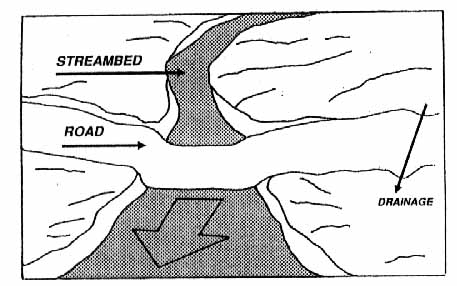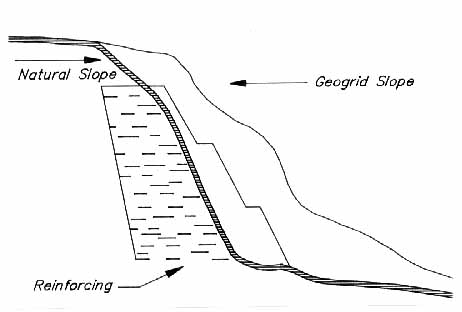California Coastal Commission
LAND FORM ALTERATION POLICY GUIDANCE
VII. EXAMPLES OF SITE ACCESS AND STABILITY

Access for Emergency Vehicles
Two-Lane Access Road

- Ingress and egress provided by 1 road.
- Merges easily with existing access and conventional roadway designs.
- 9' minimum width for each lane, required for fire safety.
- On steep slopes, disturbed area for cut and fill will extend far beyond
limits of road bed and shoulders.
- Careful drainage controls needed along road and modified slopes.
- Broad road area may be visible from great distances.
- Additional road may be required for emergency access.
Split Level Access Road

- Ingress and egress provided by 2 roads.
- Merger with conventional two lane road must be carefully marked.
- 9' minimum width for each lane, required for fire safety.
- Split roads can be "stacked" to minimize visual impact, cut and
fill can be reduced.
- Careful drainage controls needed along road and modified slopes.
- Separate roads may provide emergency back-up when secondary access is
required.
Single Lane with Pullouts

- One road providing ingress and egress.
- 10' minimum width for lane, with turnouts, required for fire safety.
- If connecting between two 2-lane roads can have a maximum length of 2640',
serving no more than 10 parcels.
- Land form alteration for cut and fill can be minimized.
- Periodic road widenings needed for pull-outs and turn-arounds.
- Not suitable for high-density vehicle use.
- May require secondary, back-up road for emergency situations.
Access across Streams
Bridge

- Can span stream bed and most riparian habitat, if stream is narrow.
- Most appropriate for high-use roads which cross perennial streams.
- Structures can be expensive, need to assure sufficient width, turning angle
and height for emergency vehicles.
- If bridge can be built without supports in stream, can avoid impacts to
flow and habitat.
- Design must consider high flood events
- A large bridge structure may dominate visual character of area.
Culvert Under Road

- Stream flow is channeled into a culvert and roadbed is constructed on top.
- Only suitable for intermittent or low-flow streams or as part of area-wide
drainage plan for directing surface flow.
- Road could provide primary access.
- For stream crossings, a culvert will disturb banks and riparian habitat.
- High flow events must be considered in design to prevent culvert failure or
impoundment behind road.
- Culvert will alter downstream flows and energy dissipation may be needed.
- Culverts are low-profile and rarely alter visual character of area.
Arizona Crossing/Ford

- Roadbed built directly into stream bed.
- Stream bank and habitat at crossing will be disturbed by road.
- Only suitable for intermittent streams.
- Road should be a low volume road or secondary access.
- If used for primary access, a secondary access should be provided for flash
flood events.
- Energy dissipater should be build in downstream side to minimize
undercutting and scour.
- Due to low-profile, fords rarely alter visual character.
Landslides or Slope Stability
Conventional Buttress Fill Slope

- Extensive grading required for steep slopes, since fill must be designed at
2:1 or 1.5:1 (horizontal to vertical).
- Extensive surface disturbance and loss of habitat from fill area.
- Often not appropriate for individual lots, due to area requirements.
- Finished slope does not blend with natural terrain min steep slope areas.
- Surface and subsurface water flows must be controlled as long as fill slope
exists.
- Drainage must be maintained; water cannot be directed to a modified slope.
Contour Graded Slope

- Extensive grading required if natural slope is steep; slope must conform to
local grading standards.
- Some disturbance of surface area and habitat.
- Finished slope can be varied to blend with natural terrain.
- Surface and subsurface flows need to be controlled, as long as slope
exists.
- Portions of natural vegetation can be maintained.
- Required careful construction and drainage control to prevent rilling and
gullying at low points in surface.
Steep Geogrid Slope

- Slope can be constructed with little grading, even in steep terrain.
- Finished slope can be steeper than a conventional buttress fill, up to 1:1.
- Surface and subsurface flows need to be controlled as long as slope exists.
- Can be constructed where space is limited.
- Finished slope can be varied to blend with natural terrain.
- Slope face is normally impervious; "pockets" can be constructed
to hold vegetation.
Landslides or Slope Stability
High Retaining Wall

- Can be constructed with very little grading.
- Structures can be expensive, need to be carefully designed and constructed.
- Drainage behind wall must be controlled as long as wall exists.
- Useful for areas with limited construction space.
- Rarely blends with natural terrain; surface treatments are possible.
- Can be used for some landslide remediation.
Several Low Retaining Walls

- Can be constructed with very little grading.
- Only suitable for small slope instabilities, or for small cuts or fills.
- Drainage behind walls needs to be controlled, as long as walls exist.
- Small walls can be camouflaged be vegetation and often can blend into
natural terrain.
- Site disturbance will not be concentrated in one location.
Gravity Wall/Crib Wall

- Walls require more disturbance than retaining walls, but less than a
buttress.
- Since structure is open, surface and subsurface flows can go through the
structure; little drainage control needed.
- Can be used for some landslide remediation.
- Facing will not blend with natural terrain; some planting between the
facing elements may be possible.
 Return to Land
Form Alteration Policy Guidance Title Page
Return to Land
Form Alteration Policy Guidance Title Page
 Return to previous section:
Section 6 Subdivision Examples
Return to previous section:
Section 6 Subdivision Examples
 Go to next section:
Section 8 Site Development Examples
Go to next section:
Section 8 Site Development Examples
 Return to California
Coastal Commission Publications List
Return to California
Coastal Commission Publications List
 Return to
California Coastal Commission Home Page
Return to
California Coastal Commission Home Page
![]()












![]() Return to Land
Form Alteration Policy Guidance Title Page
Return to Land
Form Alteration Policy Guidance Title Page
![]() Return to previous section:
Section 6 Subdivision Examples
Return to previous section:
Section 6 Subdivision Examples
![]() Go to next section:
Section 8 Site Development Examples
Go to next section:
Section 8 Site Development Examples
![]() Return to California
Coastal Commission Publications List
Return to California
Coastal Commission Publications List
![]() Return to
California Coastal Commission Home Page
Return to
California Coastal Commission Home Page